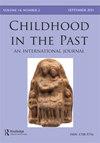How to die a good death: teaching young children about mortality in nineteenth century America
IF 0.5
Q3 ANTHROPOLOGY
引用次数: 2
Abstract
ABSTRACT Infant and child mortality in the United States are at an all-time low, but 150 years ago an infant had a 1 in 4 chance of dying in their first year of life, and older children had only slightly better odds of surviving to adulthood. Scholars have questioned parental emotional investment in periods of high infant and child mortality, but few have considered how children understood mortality and the possibility of their own deaths. Adults in the nineteenth century used a variety of mechanisms to engage children with ideas of death and dying including visits to cemeteries, photography with deceased siblings, literature and poetry, and funeral play with dolls. Sources about these various practices are combined to present a case study in how children in nineteenth Century America may have come to understand death and dying in fundamentally different ways than children in the contemporary, western world.如何善终:19世纪美国的幼儿死亡率教育
美国的婴儿和儿童死亡率处于历史最低水平,但150年前,婴儿在出生后第一年死亡的几率为1 / 4,年龄较大的儿童存活到成年的几率仅略高。学者们质疑父母在婴儿和儿童死亡率高的时期的情感投入,但很少有人考虑孩子是如何理解死亡和他们自己死亡的可能性的。19世纪的成年人用各种各样的方法让孩子们了解死亡和临终的概念,包括参观墓地、与已故的兄弟姐妹合影、文学和诗歌,以及在葬礼上玩娃娃。这些不同做法的来源结合起来,呈现了一个案例研究,说明19世纪美国的孩子如何以与当代西方世界的孩子截然不同的方式来理解死亡和死亡。
本文章由计算机程序翻译,如有差异,请以英文原文为准。
求助全文
约1分钟内获得全文
求助全文
来源期刊

Childhood in the Past
Social Sciences-Anthropology
CiteScore
0.90
自引率
0.00%
发文量
16
期刊介绍:
Childhood in the Past provides a peer-reviewed, interdisciplinary, international forum for the publication of research into all aspects of children and childhood in the past, which transcends conventional intellectual, disciplinary, geographical and chronological boundaries. The editor welcomes offers of papers from any field of study which can further knowledge and understanding of the nature and experience of childhood in the past.
 求助内容:
求助内容: 应助结果提醒方式:
应助结果提醒方式:


